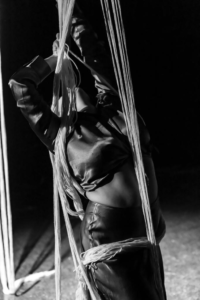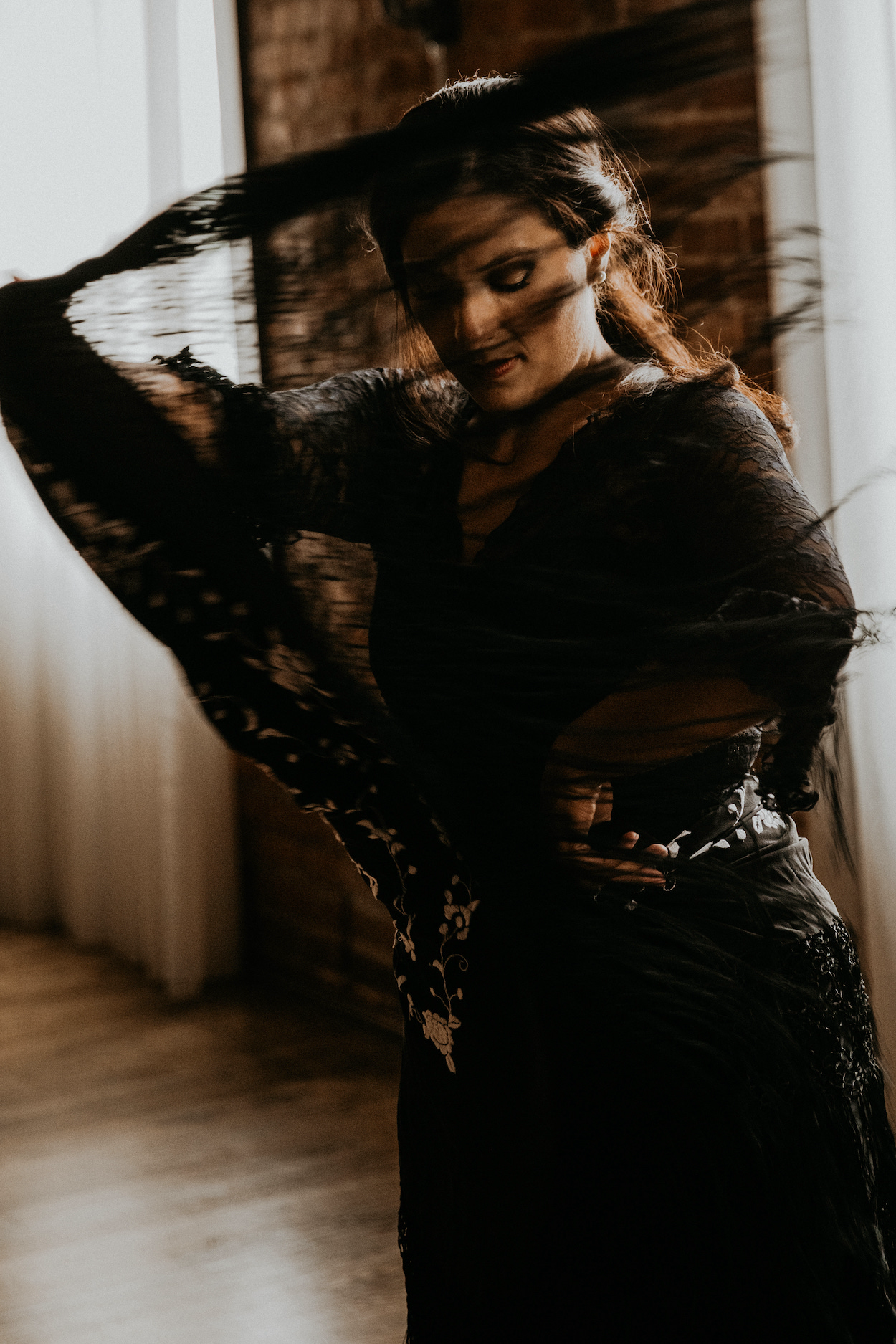Photo By: Fleeting Fox Photography
[ID: A dancer wearing black and white garments is seen in motion and wrapped in a silk shawl with her threads flying in front of her face]
After reaching almost fifteen years in exile and noticing the increasing number of fellow Venezuelan immigrants across the US and the world, I pondered the question of how to encapsulate a displaced legacy. An emergent legacy. A relationship to flamenco that is inclusive of our unique perspectives as Latinas in exile. Markme is the resulting multidisciplinary project. Within a contemporary flamenco setting, Markme aims to bring attention to the rediscovery of the Latina identity through a network of performative experiences.
The Installation
The project began with the installation Threaded Conversations, a fiber art installation built with individual cotton fibers knotted into wooden dowels. Each thread was measured, cut and knotted while I had conversations with migrant women across the US. It started as a very simple task in my creative process, to have conversations about tradition with women while cutting these threads. I wanted to begin building body memory, so I could later recall these experiences while activating the installation with performance. Little did I know that it would become this charged conceptual work about community and tradition.
The design itself emerged from a deconstruction of the ‘Manton de Manila’, an embroidered silk shawl made traditionally by artisans in Spain, used as a dance element by flamenco dancers. Thousands of single knots create beautiful floral designs and the ends are always surrounded by fringe created from the same threads.
I departed from the idea of “the clean slate” to create a curtain-like fiber installation derived from the concept of stripping this traditionally charged flamenco element of all its meaning. The same way a blank canvas is to a painting, this became an opportunity for us to reconnect to this traditional element from our unique perspectives. I was additionally inspired by Indigenous Wayuu artisans in Venezuela and their process for the fabrication of chinchorros (hammocks), and tapetes (mats). I noticed both the Wayuu people of Venezuela and flamenco artists valued these artisanal works.
I took this premise as an initial research task to understand flamenco through my own experiences as a Latina immigrantartist. Something about connecting to tradition from a clean perspective, as my emerging identity continues to transform and adapt to new settings, continues to be very present within my practice. How to connect to flamenco from my own experience as a Latina in exile, as a multidisciplinary artist, as a filmmaker? How to find a true reinterpretation of these traditional elements from a very genuine connection to their original raw materials, fiber, wood, metal without being a prisoner of their traditional structures, uses and demands?
I began the process of fabrication. Initially I thought the conversations with the migrant women would happen in parallel to its construction, in and out of the process, without necessarily being an active element in the actual construction. The labor and the monotony of the fabrication became quickly unbearable. My body was straining so much in the process that my conversations with these women became almost a necessity to break some of the monotony of the process, and to begin understanding the deeper purpose that this work had in store for me and the community I was creating. Soon I had some of these women helping me physically cut the threads. Others were videoconferencing in from various parts of the world, calling me, texting me.
Shortly, I understood the greater purpose of this piece was reestablishing connections. Some of the themes that began emerging: community as support in the migrant process; resolving and giving closure to unfinished businesses when emigrating; making visible the invisible of our stories as immigrant women; connecting to our newer communities; and allowing our identities to transform to find belonging. These concepts became evident among conversations as if the entire women migrant community was trying to shout and this work was meant to create an opportunity for these important concepts to be discussed, exposed, and performed in our communities at large.
As the work emerged, its presence began signifying an incredible responsibility. I felt as if I could visually reference so many incredible stories, each thread had so much energy and power. My body couldn’t carry so much and give these stories enough justice. I knew then that the work was meant to be interactive. I wanted the greater community to find their own connections to the installation. Our artistic legacy as Venezuelans in exile had been completely displaced and dispersed, and
I have an immediate need to give these migrant communities a chance to be part of this legacy. As well as to allow our newer surrounding communities to understand our stories and their important part in it.

In the film Markme the prototype of the installation was built. Mariana Martinez, my collaborating dancer, had to go through a process of deconstruction within her own body conditioned to tradition. The threads became a support for her to hold herself within that process, to free herself from those conventions and re-entangle herself into tradition with a completely rejuvenated dominance over traditional structures. It didn’t surprise me that the installation became this support system for her in the same way the community of migrant women became a support to me when I built it.Once more, I felt the need to expose these stories, as if they were shouting at me to be included in the conversation.
During the development of the film, we talked about ways to include these migrant women’s voices somehow in the work. We researched gestures and movement qualities inspired by key concepts in the conversations: freedom, acceptance, and belonging. This was just the beginning of a massive conceptual framework, and we understood from these early stages that the work had so much in store that needed to be developed.
The Paintings
The aim of the multidisciplinary project was to work at the intersection of art and performance, to generate value in performance art, and to create a sense of ephemerality through visual art. I wanted to create a project where both visual art and performance art needed to coexist to be fully understood.
My paintings emerged as visual documentation of climax moments of performance in the film. Every knot created in the installation during the shooting of the film itself was translated into painting and further transformed by a creative response. Following the original form that emerged from this translation, I allowed my body to react in response to the recall from the experiences in the film, as well as the stimulus given by the form itself. The resolution of movement that had been finalized with the knot as the mark of that experience left in the installation now had a way to be relived within painting. As soon as the knot covered in paint touches the wood panel there is immediate transformation. This becomes a clear interpretation of the Latina immigrant identity and how it continues to transform as it relates to new environments in the process of migration.
These painting collections continue transforming every time the project gets to be presented. The second installation, created at MACLA Gallery as part of the exhibition ‘On Traditions and Repetition’, now carries hundreds of knots created by community members that encountered the work over time. These will get individually translated into paintings for the next show, exhibition, performance.
Markme On Stage
The final phase of this multidisciplinary project intends to showcase every aspect of the work within a live music and dance production on stage. The work began in film, continued into the gallery, and now finds its way into the theater.
The third and biggest installation yet will be on stage at Journey Downtown Theater in Vacaville this February. The installation and the interactions in and through its threads will become the focal point of the entire production. Performers will activate the work’s transformation throughout the evening, and audiences will have the opportunity to be part of its evolution–creating their mark, which will then be translated into the next set of paintings. The stage becomes a setting for interactive art, and the installation becomes an ephemeral kinetic sculpture of sorts.
The work intends to highlight Latina immigrant’s stories through the transformation of the installation and the repositioning of ourselves as Latinas within the context of flamenco art and music. There is a clear focus in connecting back to materials in their primitive state, to strip our relationship to any preconceived notions of tradition. We are building ourselves from the ground up. As immigrant artists we find ourselves in constant adaptation, starting a new life, establishing connections in our communities, always looking to find a way to belong in the midst of an ever changing relationship to tradition.
This article appeared in the Winter 2023 issue of In Dance.


